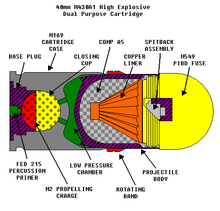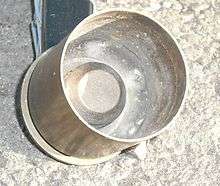High–low system
The high-low system, also referred to as the high-low pressure system, the high-low propulsion system, and the high-low projection system", is a design of cannon and anti-tank launcher using a smaller high-pressure chamber for storing the propellant. It enables a much larger projectile to be launched without the heavy equipment typically required for large caliber weapons. When the propellant is ignited, the higher pressure gases are bled out through vents (or ports) at reduced pressure to a much larger low pressure chamber to push the projectile forward. The high-low system allows the weight of the weapon and its ammunition to be significantly reduced. Manufacturing cost and production time are drastically lower than for standard cannon or other small-arm weapon systems firing a projectile of the same size and weight. It has a far more efficient use of the propellant, unlike earlier recoilless weapons, where most of the propellant is expended to the rear of the weapon to counter the recoil of the projectile being fired.[1]
Origin
In the final years of World War II, Nazi Germany researched and developed low-cost anti-tank weapons. Large anti-tank cannon firing high velocity projectiles were the best option, but expensive to produce and required a well trained crew. They also lacked mobility on the battlefield once emplaced. Anti-tank rocket launchers and recoilless rifles, while much lighter and simpler to manufacture, gave the gunner's position away and were not as accurate as anti-tank cannons. Recoilless rifles used a huge amount of propellant to fire the projectile, with estimates ranging from only one-fifth to one-ninth of the propellant gases being used to push the projectile forward.[notes 1] The German military asked for an anti-tank weapon with performance in-between that of the standard high velocity cannon and the cheaper rocket and recoilless infantry anti-tank weapons. They also stipulated that any solution had to be more efficient in the use of propellant, as the German war industry had reached maximum cannon propellant production capacity.[2]
In 1944, the German firm Rheinmetall-Borsig came up with a completely new concept for propelling a projectile from a cannon, which, while not recoilless, greatly diminished recoil and drastically reduced the manufacturing cost. This concept was called the "Hoch-und-Niederdruck System" which roughly translates to "high-low pressure system". With this system, only the very back of the cannon's breech had to be reinforced against the high firing pressures.
Rheinmetall designed an anti-tank cannon using their "high-low pressure system" that fired a standard general-purpose HE 8.1-cm mortar bomb which had been modified to function as an anti-tank round with a shaped charge.[notes 2] Normally, a mortar bomb cannot be fired from a cannon, because its thin walls cannot endure the high stress forces placed upon it. The 8.1-cm round was mounted on a rod which was fixed to a round steel plate with eight holes in it. A shear pin held the round to the rod. The round and the plate were fitted at the mouth of a cut-down cannon shell casing which contained two propellant bags. On firing, the pressure would build up in the shell casing, which along with the reinforced breech acted as the "high pressure chamber" and bled out the steel plate holes at half the pressure to the thinner walled cannon barrel which acted as the "low pressure chamber". Unlike standard cannons, in which the propellant "kicks" the projectile out the barrel with an almost instant acceleration to maximum muzzle velocity, the Rheinmetall concept "shoved" the projectile out the barrel at a constantly increasing muzzle velocity. There was recoil, but nowhere near the recoil of the 5-cm and 7.5-cm anti-tank cannons being used at that time by the German forces, which required heavy constructed carriages, and both heavy and complex hydraulic recoil-mechanisms as well as muzzle brakes to contain the massive recoil on firing. The Rheinmetall solution required only a lightweight recoil-unit and muzzle brake.
The 81 mm weapon weighed significantly less than even the obsolete 50 mm cannon and Allied 57 mm guns, less than a seventh of the weight of the 88 mm Pak it was to supplement, and less than a tenth of the weight of the famous 88 mm anti-aircraft gun turned anti-tank weapon.[3][4][5][6]
The only major drawback was its maximum range of 750 meters (in direct fire against tanks), but this was offset by an armor penetration of 140 mm and no telltale back-blast. At over 500 meters, this was superior to both the German long barrel 75 mm cannon,[7] and the American 76 mm gun, even when equipped with tungsten high velocity armor-piercing rounds. [8] The Germans ordered the Rheinmetall gun into production, designating it as the 8-cm Panzer Abwehr Werfer 600 (PAW 600).[notes 3] Only about 250 were produced before the war's end. None were reported to have seen combat.[2]
The high-low system developed on the PAW 600 was later used to propel the shells for the ubiquitous American 40 mm grenade launcher.[9]
Further development
The Allies captured and examined the PWK, but initially showed little interest in the new system developed by the Germans. The first example of a type of high-low system developed after World War II was the British Limbo antisubmarine weapon, which launched depth charge-like projectiles. The Limbo was a development of the World War II Squid, which, while effective, was limited by a set range of 275 meters. The Limbo, by opening and closing vents that varied the pressure of the gases on firing, allowed for a range that could be varied between 336 meters to almost 1000 meters.[10]
Another example was the system developed by the Canadian Armament Research and Development Establishment (CARDE) in the early 1950s to conduct supersonic flight tests on models of the Velvet Glove air-to-air missile.
M79 40-mm grenade launcher


The most well known use of the high-low system was by the U.S. Army, with the introduction of the M79 grenade launcher, shortly before the Vietnam War. The M79 fired a 40 mm shell which contained a standard fragmentation grenade with a modified fuze. The cartridge casing contains a heavy cup-shaped "high pressure chamber" in the bottom. On firing, the propellant builds up pressure until it breaks through the copper cover, venting out to the "low pressure chamber". The U.S. Army referred to their high-low system as the "high-low propulsion system".[11] Along with a heavy rubber pad on the M79 butt stock, the high-low system kept recoil forces manageable for the infantrymen using the weapon.
The M79 was later replaced by the M203, which mounts under the barrel of a rifle.[12] Later, the U.S. Army developed a higher-velocity 40 mm round using their high-low propulsion system for use by heavier machine gun-type grenade launchers found on vehicles and helicopters. Today, besides the U.S. military, the 40 mm grenade family is extremely popular and in use by armies worldwide and variants of it are in production by countries other than the U.S., with one reputable reference publication in 1994 needing almost a dozen pages to list all the variants and nations producing 40-mm grenade ammunition based on the U.S. Army's development of the 1960s.[13]
Soviet developments
Shortly after the Vietnam War ended, the Soviet Union introduced a 40 mm grenade launcher that used the high-low principle, but with a twist on the original design. The GP-25 40 mm grenade launcher fits under the assault rifle and fires a caseless projectile that is muzzle-loaded. Instead of having a case, the high-pressure chamber is located on the rear of the projectile with ten vent holes, in which the launcher barrel acts as the low-pressure chamber.[14] The ignition of the propellant gases also causes the drive band to engage the launcher grooves, similar to the American Civil War Parrott muzzle loading rifled cannon.
While little documentation exists, in the 1950s the Soviet Army developed a 73 mm cannon for wheeled armored reconnaissance vehicles that fired a munition very similar in operation to the original World War II German concept. However, it was never introduced into service, and instead the Soviets developed a low velocity 73 mm cannon that fired a rocket projectile which was ejected by a small charge in the normal fashion.[2]
Swedish use
| External images | |
|---|---|
| Pansarskott m/68 "Miniman" | |
The only other major use of a High-Low System was by the Swedish firm FFV in their development of the 1960s-era Miniman one man infantry antitank weapon. The Miniman was simpler and cheaper than anything imagined by designers in World War II. Inside what looked like a rocket launcher tube, is a HEAT projectile attached by a break away bolt to an alloy aluminum tube with ports drilled in it and which acts like a kind of high-pressure chamber. The launch tube in which it is mounted acts as the low-pressure chamber. When the propellant is ignited in the aluminum tube, gases escape through the ports and are allowed to build up in the launch tube to the point of almost causing a recoil. The break-away bolt then snaps, allowing the projectile to move forward. Unlike other High-Low Systems, gases are allowed to escape to the rear of the launch tube, achieving a totally recoilless effect.[15]
Notes
- With the simple one-man Panzerfaust the ratio was even higher.
- Today, shaped charges are commonly called HEAT warheads or HEAT projectiles. HEAT is an acronym for "High Explosive, Anti-Tank".
- In the last months of the war, the German Army re-designated it the Panzerwurfkanone 8H63 (PWK 8H63).
References
- Ian V. Hogg, The Guns 1939-45, page 155, Ballantine Books, 1970. OCLC 464065603
- Hogg, Ian (1999). German Secret Weapons of the Second World War. London: Greenhill Books. p. 169. ISBN 978-1-85367-325-2.
- 8.8 cm Pak 43
- 88mm flak gun
- Ordnance QF 6-pounder
- 5 cm Pak 38
- 7.5 cm Pak 40
- 76 mm gun M1
- Department of the Army, Field Manual FM 23-31, page 21-22, April 1965.
- Friedman, Norman (1991). The Naval Institute Guide to World Naval Weapons Systems 1991/92. Annapolis: Naval Institute Press. p. 722. ISBN 978-0-87021-288-8.
- Department of the Army, Field Manual FM 23-31, page 21-22, April 1965.
- Jane's Infantry Weapons 1976, pp. 458-459, Watts Publishing, 1976 ISBN 978-0-531-03255-8
- Hogg, Ian (1993). Janes Ammunition Handbook 1994. Coulsdon: Jane's Information Group. pp. 391–402. ISBN 978-0-7106-1167-3.
- T. Gander and I. Hogg, Jane's Infantry Weapons 1995-96, p. 203, International Publishing Group, 1995.
- Jane's Infantry Weapons 1976, p. 587, Watts Publishing, 1976. ISBN 978-0-531-03255-8